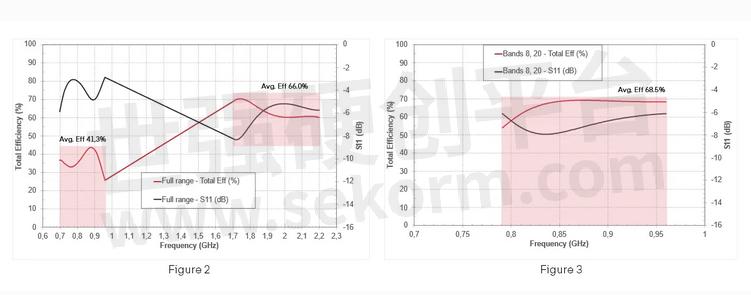Getting the Best Cellular IoT Antenna Performance: Why It’s Better to Focus on the Specific Bands in Your Region

Does this sound familiar?
Customer: “Our new device’s RF module can work with a wide range of global bands, and we want an antenna that matches them all.”
Antenna engineer: “Sure, but aren’t you only deploying in Europe? Let me show you something…”
When you are in the process of creating IoT devices, one crucial decision revolves around choosing the right cellular RF module and its associated antenna. The RF module handles wireless communication and operates within specific frequency bands. However, not all global cellular bands are likely to be relevant for your IoT device. Here’s why from an antenna perspective it’s better to focus on covering the bands specific to your deployment region:
Regulatory Compliance: Different regions have different regulations regarding the use of radio frequency bands. By focusing on the bands specific to your region, you ensure that your device complies with local regulations without excess coverage/unnecessary testing.
Optimized Performance: By matching the antenna design to the bands used only in your region, you can further optimize the performance of your device. Typically, limited bands mean you can build a smaller device.
Cost and Complexity: Integrating a chip antenna that covers all possible frequency bands can add unnecessary cost and complexity to your device. By focusing on the bands relevant to your region, you can keep your design simpler and more cost-effective.
Power Efficiency: Devices operating in the correct frequency band will have better power efficiency, which is critical for battery-powered IoT devices.
Network Availability: There’s no benefit in supporting a frequency band if the local networks don’t operate on it. Focusing on local bands ensures your device can connect optimally to available networks, delivering better performance.
Remember, while RF modules may support a wide range of frequency bands, it’s essential to focus on those relevant to your region(s) when designing your IoT device. One of the key steps is to ensure that it meets the certification targets set by various RF performance certification authorities. These targets vary by region and wireless standard. For instance, AT&T, Verizon, and T-Mobile US in North America or Vodafone in the EU have their certification processes for cellular devices. Contact your local certification body to understand region-specific requirements. This approach ensures regulatory compliance, optimizes performance, and keeps costs down.
To illustrate, let’s bring up an example powered by the Antenna Intelligence Cloud™ digital twin:
Picture a PCB board that measures 107 mm by 50 mm, coupled with an RF module capable of covering a wide range of bands worldwide from 699 MHz to 2200 MHz. Now, in this case, the goal is to match the antenna’s range to this wide spectrum. This means the antenna needs to possess multi-band capabilities and have sufficient size to encompass both the sub-GHz frequencies and the higher bands. For this project, we’ve opted for the TRIO mXTEND™ antenna (NN03-310). Let’s explore how its performance differs when it covers the entire available range (including all bands from 699MHz to 960MHz and 1710MHz to 2200MHz), as opposed to concentrating on just two of the European bands (bands 8 and 20 // 791MHz to 960MHz.

Figure 1 – A 107 mm by 50 mm PCB board with the TRIO mXTEND™ covering Cellular LPWA bands.

Figure 2 – S11 (dB) and Total efficiency (%) covering the whole range
from 699 – 960 MHz to 1710 – 2200 MHz.
Figure 3 – S11 (dB) and Total efficiency (%) covering bands 8, 20 from 791 – 960 MHz.
As can be seen in the results above, a narrower frequency range results in a better performance in the lower bands of interest having around +2 dB of improvement in the bands 20 and 8. Going beyond these results, you can consider a less complex or smaller antenna resulting in space and cost savings for the design.
In conclusion, when it comes to antenna integration, more isn’t always better. Tailoring your antenna solution to cover the bands pertinent to your region’s deployment offers regulatory compliance, efficient spectrum utilization, enhanced performance, and cost savings. It’s an important strategic choice to align your wireless communication strategy with the unique needs and regulations of your target market.
- +1 Like
- Add to Favorites
Recommend
- Ignion Announces the Smallest Virtual Antenna™ at the Wi-Fi World Congress Which is with a size of only 3x2x0.8mm
- Ignion´s Compact Antenna Powers 4K Streaming in Wireless Surgery
- Ignion’s Antenna Intelligence Cloud™ technology short-listed for 2022 Elektra Awards
- Ignion’s Innovative Antenna Solutions Drive the Future of Seamless Wireless Connectivity for Electric Vehicle Charging
- Ignion Offers Reliable Antenna Performance for Cold Chain Asset Trackers even in -40℃
- Ignion Cost-Effective and Space-Efficient Antenna for Smart Meters, Without Impact of the Meter Accuracy
- NeuronicWorks Partners with Ignion to Accelerate IoT Device Designs with Virtual Antenna® Solution
- Ignion joins Nordic Partnership Program boosting Nordic‘s cellular IoT ecosystem
This document is provided by Sekorm Platform for VIP exclusive service. The copyright is owned by Sekorm. Without authorization, any medias, websites or individual are not allowed to reprint. When authorizing the reprint, the link of www.sekorm.com must be indicated.





























































































































































































































































































































































































































































































































































































































































































































































































































































































